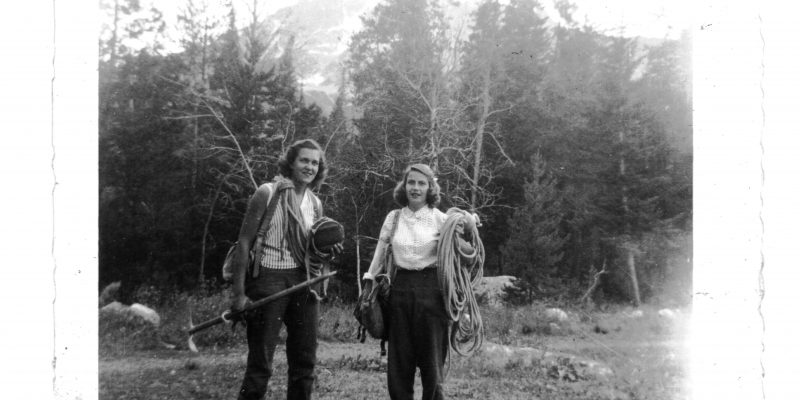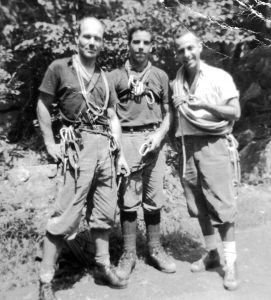
Editor’s Note: This is the first installment of a climbing memoir by former long-time Gardiner resident Louise Trancynger. 
You’ve never heard of the Vulgarian Revolution? It began quietly in 1957 with the breaking of one rule. Those who would become the Sixties Generation started showing up at the rock-climbing area of the magnificent cliffs that run for miles and tower above the land west of New Paltz, New York. At first eager only to climb, their youthful exuberance and penchant for breaking “authoritarian, inflexible rules” rapidly transformed them into the rebel Vulgarians.
The story begins in the late 1930s. While climbing Breakneck Mountain, east of the Hudson River, Fritz Weisner observed cliffs in the distance. Soon, another European-trained climber, Hans Kraus, was introduced to what turned out to be the premier climbing area of the east coast. The Shawangunk Mountains, cliffs with astonishing verticality, leaning slightly backwards as they rise close to 300 feet, are composed of hard conglomerate and have rounded stone nubs for fingerholds, small buckets for handholds, vertical cracks, for (at that time) hammering in pitons, and ledges to secure climbers on each pitch of a climb.
The Smiley family, owners of Mohonk Mountain House, were willing to risk Hans’ proposal that they allow carefully supervised climbing. What evolved was a formal structure with a strict set of rules, much like the military. Climbers were classified beginner, intermediate, leader. Spring and fall pocket schedules were published, designating beginner, intermediate and leader weekends. Leaders made all the decisions. Registration was required. It was basically an elite organization that networked with Ivy League University climbing clubs .… and it went on like this for over twenty years.
In 1955, age 23, while driving my younger brother, Dick, to hike at Lake Minnewaska, Dick spotted a climber on the cliff above the hairpin turn. We scrambled up the shale bank and found a few people who said it was a leaders’ weekend, but I could sign up for the following weekend, for beginners. Returning from the hike I rushed into the kitchen of our Victorian farmhouse on our 240-acre dairy farm five miles south of Poughkeepsie. My mother, who encouraged every adventure I had ever attempted, was almost as excited as I to hear that Dick had found the climbing cliffs I had heard of, but had previously had no idea how to locate!
I considered myself to be an experienced climber: in 1954 I climbed the Grand Teton in Wyoming; the following summer I spent every weekend at the cliffs at Devil’s Lake, about an hour out of Madison, with other members of the mountaineering section of the University of Wisconsin’s Hoofer’s Mountaineering Club; I was later a valuable member of the student team that backpacked into the Selkirk Mountains in British Columbia.
On that trip we climbed Adamont, the highest peak in the range, and though we were tied in—eight people spaced along two separate 120’ ropes to guard against falling through a crevasse—our two leaders broke well known rules of the mountain. Rule: at least one member of the team should have experience on glaciers. None of us did. When we stopped for lunch, I thrust my ice ax into the snow to use the head as a seat and the entire shaft disappeared, almost to the head! Further thrusts elsewhere produced the same result. No one seemed to realize that we were standing on a thin roof with empty space underneath. After some discussion I convinced the leaders that our combined weight could collapse the area while we stood together to eat.
Rule: on steep pitches strong man, the leader, stays high to belay (draw up the rope as a climber ascends, or feed out the rope as a climber descends) to arrest a potential fall. Oscar, leader of the first rope, leaned over the crevasse separating us from a solid wall of glacier and climbed 20 feet to the top. We followed, one at a time. Rules were forgotten. Neither leader belayed. After lunch, stranded on our lunch site, we had to descend the way we came up. Oscar led his rope down. Speedy, the gifted athlete leading our rope, followed, leading our rope down. As the fourth and last person it was I, not the “strong man” left high, standing on the edge of the wall. When Nancy, third on the rope, tried imitating Speedy’s fancy footwork instead of relying on her ice ax for balance, I prepared for her potential fall. She fell. Experience and instinct told me what to do; I dropped over sideways, away from the edge, like a tree crashing to the ground, plunging my ice ax into the snow. Nancy was lucky: hanging by the length of the rope between us she was hauled out of the crevasse in no time, and then limped back to base camp using Speedy as a crutch. Her twisted knee recovered in a few days.
One month later, I excitedly attended my beginner’s weekend in the Shawangunks. In spite of the rain I joined about 20 climbers who converged on Schleuter’s rooming house. Margo Schleuter, a native of Germany, was an excellent cook and gregarious hostess. Climbers partied, ate and stayed for the weekend there. In those days, Appalachian Mt. Club leaders had total control of who climbed, when, where, and with whom, so right away I was confronted by an Appie rule: No matter how experienced I was I could not attend the upcoming intermediate weekend unless I was qualified by a leader. Doug Kerr, of “Doug’s Roof” fame (name of his climb) volunteered to lead me up “Easy Overhang.” It was fun demonstrating my ability to belay the leader up the climb, feeding out the rope just enough, ready to securely stop the rope in the event of a leader fall. With Doug tied into a belay ledge, I effortlessly reached hand over hand up the easy climb with the rain pelting hard on my face. Returning to Schleuters, both of us soaking wet, Doug officially designated me to be an intermediate climber.
On my first intermediate weekend I was teamed up with two top women leaders: Maria Millar, who, in 1946, had put up the route she named “Maria”; and her friend, Ruth Tallan. We climbed “The Three Pines,” an easy climb. Leaders who had heard about our mishaps on the Selkirk expedition had laughingly asked how many of us came back alive from one near disaster after another. So imagine my chagrin when Maria and Ruth chastised me for even showing up. On each belay ledge, as they supervised me securing myself to a piton, they kept trying to convince me this was no place for a young girl to find a husband. Why was I being admonished? In spite of my climbing experiences I believe I didn’t fit the mold. I was a farm girl with only a State Teacher’s College education and might be future competition for the few women climbers at the Gunks. As it turned out, I proved them wrong: I married a climber, and eventually another climber. That second climber, Hank Trancynger, led me up Devil’s Tower in 1997, just shy of my 66th birthday.
Please come back and enjoy installment number two in the next issue of The Gardiner Gazette. We’ll find out what happened when the Appie rules got to be just too much for those who would become known as The Vulgarians …
